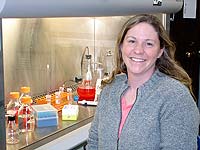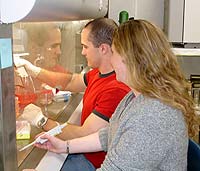Research/Academic Showcase
Texas Tech University
The Science of Hooking a Trophy Bass
National Journal Honors Chemistry Professor's Work
Three Honors College Students Score Goldwater Scholarships
Preserving Texas Music for Future Generations
Texas Tech University Health Sciences Center
School of Medicine Gets New Dean
Researcher Seeks Answers for Diabetes
Alumni Highlights
Local Alumni Association Chapters
Development
School of Pharmacy Program Expands to Abilene
From here, it's Possible Contest
Athletics
Kristy Curry Named Head Coach of Lady Raiders
Morgan Earns National Pitcher of the Week Honors
Texas Tech University Press
Take a Thrill Ride Among Southwest Fossil Digs in "Quarry"
Helpful Links
Researcher Seeks Answers for Diabetes
Research/Academic Showcase
 Jannette Dufour, Ph.D., researcher and assistant professor in the Department of Cell Biology and Biochemistry, stands in the laboratory where she hopes her research will help diabetics. Dufour recently received a three-year, $412,254 grant from the American Diabetes Association.
Jannette Dufour, Ph.D., researcher and assistant professor in the Department of Cell Biology and Biochemistry, stands in the laboratory where she hopes her research will help diabetics. Dufour recently received a three-year, $412,254 grant from the American Diabetes Association. The Hendricks lived a healthy lifestyle and there was no history of diabetes in their family. When their then 4 year-old daughter Abby began losing weight, drinking a lot of water and needing to urinate frequently, they knew something was wrong. Abby was diagnosed with type 1 diabetes.
The Hendrick family now has educated themselves on the risks, treatment and the need for research for diabetes.
Texas Tech University Health Sciences Center researcher Jannette Marie Dufour, Ph.D., recently received a three-year grant from the American Diabetes Association in the amount of $412,254.
“I see their faces and have gotten to know many families affected by diabetes,” says Dufour, who is an assistant professor in the Department of Cell Biology. “I have met Abby and see first-hand the need to find answers to so many issues with diabetes. They are parents who want answers for their children and children who want answers for their parents and grandparents. It affects all of us.”
Abby’s father, Trent, says with all of the advancements of diabetes treatment, most diabetics can manage their disease and live a long, healthy life.
“Be aware of the symptoms and risk factors,” Hendrick says. “We all need to educate ourselves about diabetes.”
 Abby Hendrick was diagnosed with Type 1 diabetes when she was just four years old. Dufour's research could someday allow successful islet cell transplantation in all persons with type 1 diabetes, including young patients like Abby.
Abby Hendrick was diagnosed with Type 1 diabetes when she was just four years old. Dufour's research could someday allow successful islet cell transplantation in all persons with type 1 diabetes, including young patients like Abby.According to the ADA, 20.8 million people in the United States have diabetes. Type 1 diabetes is usually diagnosed in children and young adults. In type 1 diabetes, the body does not produce insulin.
For people without diabetes, the pancreas makes insulin and enzymes that help the body digest and use food. Spread all over the pancreas are clusters of cells called islets. Islets are made up of two types of cells: alpha cells, which make glucagon, a hormone that raises the level of glucose or sugar in the blood, and beta cells, which make insulin.
Dufour says insulin is a hormone that helps the body use glucose for energy. “If your beta cells do not produce enough insulin, diabetes will develop,” Dufour says. “In type 1 diabetes, the insulin shortage is caused by an autoimmune process in which the body's immune system destroys the beta cells.”
In an experimental procedure called islet transplantation, islets are taken from a donor pancreas and transferred into another person. Once implanted, the beta cells in these islets begin to make and release insulin.
 Dufour works with Brent Fossum, a medical research technician at the Dufour Lab.
Dufour works with Brent Fossum, a medical research technician at the Dufour Lab. “Researchers hope that islet transplantation will help people with type 1 diabetes live without daily injections of insulin. But this treatment requires continuous immunosuppressive therapy, which can cause adverse side effects,” Dufour says. “And the procedure is limited by the inadequate supply of human organ donors, making it impractical for most patients.”
Sertoli cells are able to protect co-transplanted islets without the need for immunosuppression therapy suggesting they could be used to solve both problems. The focus of Dufour’s research is to take advantage of the immunoprotective properties of Sertoli cells as a means to eliminate the need for continual immunosuppressive therapy for islet transplantation.
This would allow the successful transplantation of an unlimited supply of insulin-producing tissue. Dufour says this can be achieved either by co-transplanting pig Sertoli cells with pig islets and/or altering Sertoli cells so they produce therapeutic levels of insulin.
The second area of focus for Dufour’s research is to identify and characterize immunoprotective factors produced by Sertoli cells as the first step in understanding the mechanisms behind their immunoproductive properties. This research will significantly advance the use of immunoprotective Sertoli cells as a novel solution to the problems associated with islet transplant rejection. One day, this information could allow successful islet transplantation in all persons with type 1 diabetes, including young patients.
“We are extremely excited by Dr. Dufour’s research,” Hendrick says. “Unfortunately, it is likely that we all know someone who has diabetes. Hopefully with reseach such as hers, we can move one step closer to living a healthier life.”